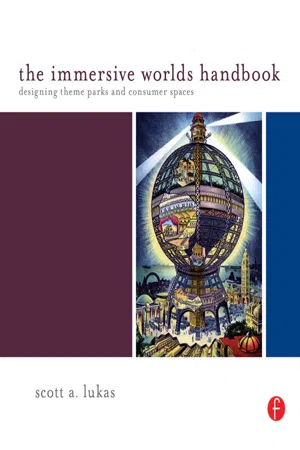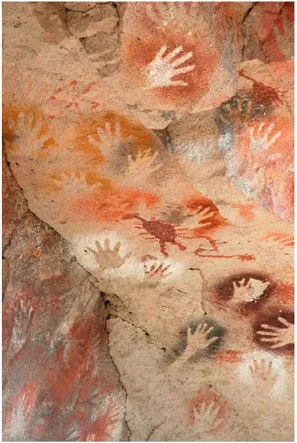Immersive Worlds
An immersive world is a place in which anyone can get wrapped up. Whatever your background in life, whatever your political or religious views, and whatever you enjoy doing in your spare time, an immersive world will take you in such that you won’t want to leave. This book is about the variety of immersive worlds that have existed and the ones that can be designed, and it details how design can be applied to the many spaces that are typically a part of an immersive world—theme parks, restaurants, cruise ships, hotels, interpretive environments, cultural museums, casinos, mixed-use spaces, shopping malls, resorts, lifestyle stores, and other spaces.
Etymology of Immersive World
immersion
Mid-15th century, from Lower Latin and Latin, meaning, “plunging or dipping into.” Later, in the 1640s, meaning “absorption in some interest or situation.”
world
Circa 1200, meaning “the known world” and “the physical world in the broadest sense, the universe.” In Gothic meaning, the “seed of man,” and in Old Norse meaning, “the middle enclosure” or “where humans dwell.”1
When we combine the ideas of immersion (“absorption in some interest or situation”) with world (“the known world…in the broadest sense”) we get a place known as an “immersive world.” You might be wondering, “Isn’t every world, in some sense, an immersive world?” Yes, it’s true that wherever we go—whether on a vacation to a tropical island, on a mundane trip to the grocery store, or on a commute on the freeway to our place of work—we are being immersed in the people, situations, smells, sights, and other senses of that world. The immersive world has a more specific meaning though. When we talk about the immersive world we mean a place where people want to be. This is a place, whether a restaurant, theme park, or café, where people enjoy what they are doing. They become immersed in two senses. First, there is something about the place—its evocative quality—that creates a set of complex feelings in the person there and this results in the delight and willingness to stay in that place. Second, the person, him or herself, gets wrapped up in being in that place and, in his or her mind, creates associations and feelings that result in more pleasure. As you’ll soon see, immersion in a world is a two-way street. But more on that later.
What Is a World?
We have talked briefly about an immersive world—the subject of this book—but in order to understand how to create immersion in a space we first need to go back to the beginning. What, exactly, is a world?
Defining a World
As the earlier definitions suggest, a world is literally everything that is known to us, in the broadest possible sense. The planet Earth could be called a world (an astronomical definition), the Mayan culture could be referred to as a world (a cultural definition), the Blizzard Entertainment MMORPG World of Warcraft is considered a world (a technological definition), some people refer to things like “the media world” (a social definition), and many would call theme parks and other places of immersive entertainment magical worlds (a design definition). A world can be understood in many senses, but for the purposes of this book we will be considering worlds that are a part of some entertainment, consumer, or branding experience. Let’s look at a definition of “world” that can be more easily applied to immersive spaces.
A World
A world…is a place inhabited by beings. It is complete, diverse, consistent; it has a background or history, and a culture. It is ever-changing or evolving and is characterized by relationships and forms of interconnection.
The definition of a world that we are using in this book has some advantages. First, it indicates that a world is always made up of beings. “Beings” is used because it allows us to include everybody and everything in a world. If we are inside a theme park attraction, for example, we can include the people or actors who are playing parts in that attraction, the guests who are paying to see it and be a part of it, and the sometimes fictional begins (like creatures, animals, space entities, etc.) who also play a part in the world. Second, by saying that the world is “complete, diverse, and consistent” we acknowledge that the world, like any world, isn’t one dimensional, bland, or uninteresting and that it is complex and consistent in its complexity throughout its spaces. Third, by including a “background or history, and a culture” we see that a world isn’t shallow. It’s made up of so many things that we must acknowledge as designers. Consider how the popular James Cameron film Avatar would have been had Cameron not spent so much time conceptualizing the cultures of the Na’vi and the humans within the Avatar world. Last, by acknowledging that a world is always changing or evolving and is characterized by relationships and connections, we see that a world is never static—it is something that is always on the move.
Worlds—Big and Small
Using this definition of a world we can begin to talk about how to create an immersive world. First, let’s look briefly at the issue of scale. Our earlier look at the different astronomical, cultural, technological, and other definitions of worlds showed us that worlds can be understood in so many different senses. The same can be said of the scale of a world. A world can be an entire planet (perhaps one that will form the fictional background of a theme park that you are creating) and it can be a very small place on that planet (like a small ecosystem on one of the planet’s continents). These two senses of a world are key. The first “big” world is a macro world or one that has a large scale. The second “small” one is a micro world or one that has a smaller scale. Big and small are both variable. Scale is related to the actual proportions and dimensions of the spaces that you will be creating in your own venues. Whether you design a macro or micro world, you will need to keep in mind the attention to details, the sense of believability and realism, and the need to keep people excited about the world they are visiting. As well, it is likely that the space that you are designing might have multiple worlds—big and small—within it. In 2011, while visiting the Field Museum in Chicago, Illinois, I was intrigued to walk through exhibits that focused on the makeup of soil (the micro) world and on the life of whales in the ocean (the macro). What this reminded me is that all worlds—whether big or scale—can intrigue and interest us.
Creating an Immersive World
Whether we are creating a big or small world, or some combination of both, we are interested in creating an immersive world. Combining our definitions of world and immersion we get an immersive world or a place in which guests can become fully absorbed or engaged. Anyone is an important point of emphasis here. While in some cases we might design a world that is intended for a more specific group or audience—such as a religious theme park or museum that is geared at “all people who are religious” or “all people of a certain religious denomination”—nine times out of ten we want to create a place that can be enjoyed by anyone regardless of their background. Later I will tell you a short story about the historic amusement parks of Coney Island. One of the most uplifting things about Coney Island amusement parks was that they were places where, in the words of Giuseppe Cautella, “democracy meets…and has its first interview skin to skin,” meaning that people—rich and middle class, men and women, black, white, and other ethnic groups—could all enjoy the attractions that had been created for them.2 Some of the rides there, like the Human Roulette Wheel, in fact literally threw people together. Talk about immersion!
In today’s world, we are lucky that because of multiculturalism and more general good will among people that guests don’t have to be literally thrown together in the same space to enjoy it. It’s more on you, the designer, to create intriguing immersive spaces that will be ones that guests will visit again, again, and again. As you create an immersive world, you will find that the places you have designed—because of the things that we will be talking about later—are ones that people come first to experience, second to revere, and third to love and to incorporate as part of their life traditions. An immersive world, as we’ll see, simply (and perhaps existentially), is.
Application—Iconic Spaces
Sometimes a certain place is iconic to us. It could be something about where it is, or what sorts of features it has—perhaps the certain visual look of a mountain range of snow-covered peaks—or perhaps it has to do with your memories and the events that happened in that place. Whatever the reasons, we attach our memories and feelings to certain places while others remain entirely forgettable. As designers we can think more closely about the certain feelings and memories that we associate with an iconic space. Take a moment here, in this application, to do just this. On a piece of paper, make a note of a place that is iconic for you. Next, write a list of associations that you have with that place. This can be free form. Just be sure to jot down key words that represent your fondness for that place. After you have completed the list, try to organize your word associations into categories—spatial, event, sensory, or your own versions. The key is to group the associations into subsets. Then observe which of these subsets relate to the others. If you like, a design partner can work on one and the two of you can share your lists. As you finish considering the list, focus on how you could translate some of the same fond associations that you had with your iconic space into an iconic space that you can create in a design world.
Cave Art
The immersive world that you considered above is one that had a personal effect on you. It was, we could say, evocative, meaning that it produced something vivid, memorable, and profound in you. For any of us, when we have very vivid memories of being in a place we have them because something about the place stays with us and because we were once, in whatever way, immersed in that world. After the fact we could describe it, in fine detail, to any person who asks us. It’s a part of us.
One of the earliest and more important immersive worlds can be found throughout Europe and other parts of the world. Step back in time about 30,000 years before now and you would have found cave art in some of the places that you would have lived. On the walls you would have seen images of bison, deer, and horses, as well as images of human hands and other representations. You would have likely felt something immense, something bigger than yourself when you looked at the images on the walls. The images on the walls and the caves themselves would have had an effect on you. The key to cave art, like the themed consumer spaces of our world today, is that both the thematic artistic representations and the fact that humans interpreted the images, used them in some way, and could relate to them, and likely others through them, are what made cave art significant for people.
Wouldn’t You Know It!—Cave Art
Well, it turns out that cave art gives us both our first insight and our first bit of confusi...




